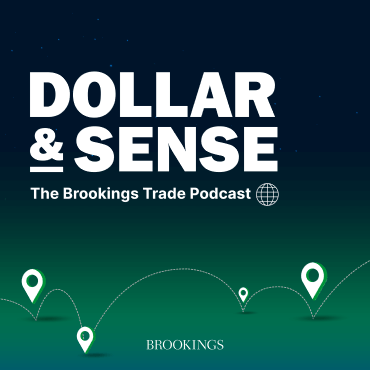In the face of economic and health challenges posed by COVID-19, Congress, an institution often hamstrung by partisanship, quickly passed a series of bills allocating trillions of dollars for economic stimulus and relief. In this episode, Sarah Binder joins David Dollar to discuss the politics behind passing that legislation and lingering uncertainties about its oversight and implementation. Binder and Dollar also cover lessons from the federal response to the 2008 recession that could be applied today and what we might expect to see in future legislation before Congress.
Related content:
Congress moved quickly on the massive emergency spending bill. Here are four takeaways.
How will COVID-19 reshape America’s logistics workforce?
Independence and accountability: Congress and the Fed in a polarized era
Americans give President Trump poor ratings in handling COVID-19 crisis
This transcript has been lightly edited for clarity.
DOLLAR: Hi, I’m David Dollar, the host of the Brookings trade podcast, Dollar & Sense. Today my guest is Sarah Binder, a senior fellow in Governance Studies at Brookings and a leading expert on U.S. legislative politics. Our topic is going to be the politics behind these massive relief and stimulus bills that we’re getting in response to the coronavirus. So welcome to the show, Sarah.
BINDER: Thanks for having me.
DOLLAR: The usual storyline in Washington is partisanship, political paralysis, we can’t get anything done. So it strikes me as pretty remarkable that Congress passed three bills. The most recent is this massive 2.2 trillion dollar relief and stimulus bill. So what’s the politics behind this quick action?
BINDER: Sure. I mean, keep in mind, I think the conventional wisdom in this case is correct which is that, by any of the metrics we have, this has been a Congress and a president – not just in the current Trump administration, but for easily a decade if not more – that struggles to legislate. Sometimes because they disagree about what the problems are, sometimes because they disagree about how to solve problems. Add it all up and stalemate on most of the issues of the day: Immigration, climate change, entitlements, future debt. Those are the issues on which Congress and the parties have stalemated.
So as you said in this past month, in March, we had three really very quickly put together of increasing scale legislative successes. How do we account for that – going from an 8-billion-dollar funding bill for essentially health care workers all the way up to 2.2 trillion, if not more, in the CARES Act that was enacted at the end of March? How do we account for that? Well, we have this notion sometimes that it takes crisis for Congress to act. That in a time of crisis, the two parties are finally willing to put aside their own particular priorities in order to get something done. And you hear that from members. Chuck Schumer, the minority leader, after it passed said something along those lines. The majority leader in the Senate, Mitch McConnell, said something like “the American people expected us to act and we did.” But I think we need to make sure we don’t just think that they rise to the occasion because we expect them to. We expect Congress to act on a lot of issues on which they don’t act. So crises may be necessary, but it’s not always sufficient.
What went on here, I think particularly in this last act, the 2.2 trillion-dollar CARES Act, there is this political pressure not to be blamed for blocking something in face of real dire need. Rising caseloads, millions online for unemployment benefits, caseloads and deaths in hospitals. It would be very clear which party would be blocking it if at the end of the day they didn’t put themselves together to enact these measures. So I think that pressure – more so than statesmanship or “Gee, we really have to act this time” – it’s that pressure not to be blamed that time and again when the consequences of inaction are so big that propels action. And we saw it in spades over the last month for sure.
DOLLAR: So the bill has quite a few different components. For an economist, one of the really striking things we’re seeing, we’ve had steady job creation for 10 years. 22 million jobs created over 10 years. Now they’ve been lost in four weeks. It’s just really striking. So obviously there’s a need to bolster unemployment insurance. There’s a lot of money for companies, so that struck me, and what I view as a relatively small amount of money for state and local governments. Their tax revenue is cratering, they’re not really supposed to borrow, so why is there so little for state and local governments? Why is there so much for companies?
BINDER: Well, it’s a good question. I think in part it has to do with the ways in which lawmakers make deals – at least from a political perspective here. We often sometimes have the sense that there’s one big pie and they divide it up. The majority gets more and it is sort of zero-sum: for you to win, I have to lose. But that’s not really the model that generates these big packages. It’s much more enlarge the pie and a win-win for both sides. Democrats get their most preferred outcome, Republicans get their most preferred outcome, and it gets put together in something like the CARES Act. And so we know from the discussions that have been going on about phase four, about whether to expand small business loans or about whether in fact it should be matched with more money for state local governments and for hospitals. We know the parties have different priorities. And so when we look back at CARES and we look at the sheer amount of money going to corporations, for sure, there’s some element of saving the economy. Absolutely, given the number of jobs employed from airlines down to the coffee store on the corner. So there’s certainly a policy need there, but I think the politics here are driving that the two parties care about different constituencies and they bring those demands to the table. When you add them up in this severe shock you get to 2.2 trillion dollars of aid, really relief aid, not stimulus, but just emergency relief.
DOLLAR: Right. So once this kind of enormous bill is passed the key issue then becomes implementation. There’s always a risk that you rush to pass something with a big price tag on it but the real effect on the economy comes from dispersing money to companies, local governments, unemployment insurance, et cetera. So do we have a sense of how implementation is going now that we’ve had this for a few weeks?
BINDER: So I think, in a word, we might call it “uneven.” And to some degree it is uneven because we live in a federal system here where many of these moneys are dependent on the state capacity. Right, the capacity at the state level. Certainly in terms of the news that’s been written about the unemployment benefits and the ability of the states to deal with the crush of applicants, which is unprecedented, right, in terms of the size and the timing. Just look at those graphs which keep showing up on the front page of the newspapers of how high the spike of millions of people applying for unemployment insurance. A state like California may deal with it quite well; other states might have a lot creakier ability to ramp up, and certainly the stories about Florida having to return to paper applications and so forth. So federalism matters here and the degree to which states have invested in the technology and government employees in order to make the system work.
Some of it is the small business loans – which are basically grants – there is a sense, I think, of the flooding of that small agency with this enormous amount of money – 350 billion dollars – working through the banks, of course, but there’s probably some degree of this is an amount of money that’s just at a scale for the type of programs the SBA normally administers. So, there’s concern here. I think we take for granted that Congress passes something and it gets implemented. You can really see the demands for speed and the amount of pain that’s out there, the amount of relief that’s needed. It’s very hard for a governmental system to get into gear certainly that quickly overnight.
DOLLAR: Right. I’ve been reading quite a bit about the small business loans and a couple of the results are kind of predictable. First, geographically, there’s a lot more applications in Texas than in New York, even though the crisis is much more severe in New York. There are a lot more applications from manufacturing and construction than there are from restaurants and retail which is where most of the job loss is. So it’s really hard to just build up a program like this at scale in the immediate face of a crisis.
Now, the closest modern analogy we have to what we’re doing with this big bill is the 2008-2009 financial crisis where again there was a big program to help companies. A lot of the money went to big corporations and economists generally view this as pretty successful. I actually think we probably needed more stimulus in 2008-2009, but the effort to save companies seemed to work pretty well. But it’s really unpopular among the public. So I wonder if we learned from that lesson? Have we built in more protections against nepotism and corruption? That seemed to be the fear in 2008-2009 is that this was a big slush fund lacking transparency. As I said, it was quite unpopular with the people after a couple of years. So have we learned from this experience?
BINDER: Well, I think to some degree there’s been some learning. I would say, to a remarkable degree, the dynamics of putting together the TARP bill that came to be known as the Wall Street bailout in 2008, the dynamics of that bill and how it came to be looks an awful lot like the corporate buyouts and the corporate aid and the small business aid that is put into the CARES Act. In 2008 the Treasury Secretary, Paulson, essentially wrote up his plan for TARP on a piece of paper and all the discretion went to the Treasury Secretary. There was no oversight at all. It really was as close to a blank check as I’ve seen. It was a three-page piece of legislation. Not to say that longer is better, but longer implies some degree of oversight. And that generated immediate pushback, particularly from Democrats who were the majority party at the time during the end of the Bush administration.
What the Democrats pushed back on created sort of several layers of oversight. That’s what we’re seeing roughly the same this time around, which is that the administration comes forward with Secretary Mnuchin and a plan for a very large bailout funds but no oversight. And again, we see Democrats, this time House majority and Senate minority, pushing to basically impose the same sorts of oversight that we saw last time. This is both the creation of a special inspector general which I think from 2008 I think got high marks, what we call SIGTARP, in terms of the ability to trace the actual detailed level of spending. But then also a congressionally appointed oversight commission on which Senator Elizabeth Warren, now senator, had really got her public started, as it were. The CARES Act has something similar here: both the creation of a special inspector general within the administration and within treasury; creation of a congressional oversight committee; and then another layer, essentially the Council of Inspector Generals within the federal government doing another layer of what they called pandemic oversight.
What have we learned here? Structurally, we’ve taken 2008 and applied it over the CARES Act. There are some pretty strong signs here that oversight is not going to be nearly as rigorous – or it seems to be it will be not nearly as rigorous as it was in 2008 – both because of the president’s attitudes towards inspector generals but also there seems to be some slowness in appointing the Congressional Oversight Commission which currently has one lone member shooting off letters to the Fed and Treasury. So on that angle, in terms of how it’s institutionally structured, there’s been some effort to put into place what we learned about from 2008.
In the bill itself, in the CARES Act, there’s been an effort to write in some of the oversight, some of the restrictions on lending and grants, that were applied belatedly in 2008. But there are many more waivers, it seems to me, in this version in the CARES Act than there was in the past. Whether that’s a matter of how quickly the package came together, what it took in a period of split party Democratic and Republican control on the Hill to get the bill out the door, there is a fair amount of discretion here despite the transparency that’s imposed with these bills.
DOLLAR: It seems to me an area where you’re really trying to find a balance. There have been surveys of small- and medium-enterprises. Many of them indicate they can’t survive more than about two or three months in this current situation without running their business and without getting any revenue. So obviously we have to move quickly. If it takes more than a few months then probably it’s gonna be a hopeless situation for a lot of these small firms. On the other hand, it’s legitimate for the public to want to have some serious ex-post accountability. So it seems to me that’s the balance to move quickly but then have some ex-post accountability.
BINDER: I would say the other lesson from the financial crisis is Congress did rewrite some of the Federal Reserve Act and in particular went after these emergency lending programs that we call 13(3) to lend an emergency in exigent circumstances. And they wrote in a fairly detailed set of transparency requirements: lending from the Fed’s discount windows, lending from these emergency loans. And so the Fed understands these demands for transparency that were not in place. They were not in the law in 2008 and 2009. So I think there’s been some adjustment of expectations in the Fed. Whether that affects how they make decisions on lending, whether that induces a better eye toward the optics of what they’re doing, that’s hard to know. But the regime has really changed here in terms of putting it into statute, which does give Congress a stronger arm to try to impose and get more transparency on where the money is going. The demands of time here really weigh heavily, I think, on both sides here and particularly the Fed and their ability to judge the collateral they’re taking and yet get the money out the door quite quickly.
DOLLAR: My impression is the Fed is doing a pretty remarkable job. I was worried after 2008-2009 we might hamstring the Fed so much with new regulations that it would make it hard to move quickly in a crisis, but so far Jay Powell and his team seem to be doing a pretty remarkable job.
BINDER: Yeah, I think they’ve been learning and innovating and since the financial crisis. They’ve not just been sitting on their heels there. And to some degree, this fusion of Fed lending with Treasury involvement that’s written into the CARES Act, I think sometimes we overestimate the degree of autonomy and independence. In a financial crisis – Bernanke’s said immediately in the wake of last crisis – in financial crisis you cooperate with Treasury. We are in this boat together, he essentially said. They see eye to eye. And so concerns that Treasury is going to monopolize or harm the decision-making that’s going to the Fed, I think there’s much more synergy, as you suggested, than what otherwise might have been a reaction coming out of the financial crisis when Congress rewrote the act.
DOLLAR: Sarah, you referred in passing to a follow up bill. It seems very likely that there’ll be at least a fourth bill in this series. So what are some of the priorities for the fourth bill? What are the two different parties looking for and what kind of compromise are we likely to get?
BINDER: Well the Republicans stance so far coming from the Senate side really has been that the SBA loans here, grants, the small business program in the CARES Act is all but about to run out of money. Let’s double the money, infusion money, get it into the hands of the SBA to get to banks to get to borrowers. That is imperative. That’s Republicans’ top priority, and at the moment their stand has been that’s the only thing we should be doing. Sure, there’s more need, but let’s push it off until we have more time.
Democrats have said, absolutely, we’re all on board for expanding the SBA money, but there are other big needs out there. First, to put money into the coffers of state and local governments. And second, to put money in the coffers of hospitals which are obviously on the front lines here.
The dispute has really put us back in the usual mode of congressional brinkmanship which is –you and I from outside the institution, we can see the obvious solution. Match the money on both sides, put it together, and in these weird times use unanimous consent, voice vote it, and get the money out the door. But at least the storyline coming out here has been the Republicans don’t want to give over money to state and local governments. Not now. Democrats have made overtures to the Treasury Department and so there are discussions going on and by the time our podcast comes out we may yet have had a win-win deal. Both parties get their most-top priorities, they put them together, you give a little to the other side – although on this side there’s not much giving up to the other side – match those priorities and get the bill signed into law.
DOLLAR: Right, as you say it seems like a pretty obvious compromise. I would guess that playing politics with this right now might be dangerous. I understand that some Republicans have a kind of philosophical view about not having too large a government, but at the moment local government is a really big employer in the United States. So aside from the decline of services you’re talking about millions of jobs that could be lost there. So, as you said, you would think it would be relatively easy to just split the differences and find a compromise in the next couple of weeks.
BINDER: Yeah, and I think on the partisan angle here the majority leader did this once in the past week. Whether he does it again, we don’t know. He’s basically put on the floor a motion to pass just the SBA money and the Democrats objected. Democrats offered their version and the Republicans objected. And, you know, it seems unkosher to talk about partisanship in these immensely difficult times, but the majority leader’s not above playing a partisan game here to try to get the storyline to be it’s the Democrats who are blocking action. And that’s valuable for a political partisan leader to send that message, but the Democrats didn’t fall for it, and in part they did fall for it because they know that there is some large constituency for what they want to add to the bill. And they know that the Treasury Department and the Trump administration want to do whatever they can to rescue the economy here so, you know, there are no ideoloagues in foxholes and so forth. So it’s just that there’s a partisan game going on here and no amount of crisis of the country can stop politicians from playing, in this very partisan period, a partisan game.
There is another question about, and you sort of hinted at, why is it that Republicans, at least on this go round seem resistant to giving more money to state and local governments? And to some degree, and this may be more over-thinking what’s going on within the Republican conference, but think about the ways and who benefits or which type of states benefit when you send money out to the states. And typically there’s a formula, whether it’s written into statute or the government agency is allowed to write it, but typically money that goes to states is based on population. Not entirely, but largely based on population. And if you look at the largest states outside of Texas and Florida, they are Democratic led and Democratic voting states. And I don’t want to say quite so bluntly that Republicans don’t want to give a lot of money to the opposite party, but I think you do have to think about the beneficiaries of state and local government funding and precisely who benefits. And particularly if your earlier point about enlarging government: is this their top priority? That’s clearly not their top priority for whatever range of reasons.
DOLLAR: Let’s talk a little bit about infrastructure. So I have mixed feelings about this because as far as true emergency relief you wouldn’t necessarily want to go through infrastructure which even relatively simple things like just fixing potholes tends to take more time. But I think this crisis is going to be with us for at least 18 months – the economic crisis. So as you look out further in time and we’re going to have a shortfall in demand, we have infrastructure needs in this country and this is actually a rather good idea. So why is it so difficult to get Congress to agree on some kind of infrastructure package?
BINDER: Great question. And it is unfortunate that it’s become such an inside-the-beltway joke that “oh, it’s infrastructure week again” whenever anybody mentions infrastructure meaning that it’s going to be proposed and 24 hours later we’re not paying attention again. So what is the problem? What’s the obstacle here for the parties? I think at the end of the day it really, to some degree, comes down to the financing mechanism for doing a real infrastructure bill most of which would revolve around raising the gas tax, particularly for the element of programs that come out of the Highway Trust Fund. They get in these every five years or so bills – roads, bridges, public transportation systems, and so forth. Everything that gets funded out of the Highway Trust Fund. Republicans are ideologically disposed against raising the gas tax. Whether that’s in part a just a anti-tax increase mantra of the Republicans. That’s possible. It’s also possible that they prefer not to be spending money on the broad range of things, urban transportation systems, which typically benefit necessarily Republican constituencies. That’s also possible. The gas tax is a bit regressive in terms of the people who live in rural red states who drive a lot of distances but end up disproportionately funding the gas tax than others. So, there’s a range of reasons why the Republicans as a party might be reluctant to do the type of infrastructure stimulus bill that we’ve been talking about for years now in Washington.
The other thing to keep in mind is when the two parties talk about infrastructure I think they have different things in mind. Democrats seem to have a very broad array of what counts as infrastructure. Whether it’s cyber Internet access, green technology, like a whole host of provisions in sectors that come under infrastructure. Democrats have also said they want it to be their Green New Deal. They see the infrastructure bill as a way to look for renewable energy and investment in those types of energy networks and so forth. So, again, it seems easy, and it probably could be easy, but political commitments, ideological commitments, role of government, it all kind of ends up in this otherwise simple issue of infrastructure and I think that’s partially why year after year it’s just put infrastructure off the table even though, you and I, no matter where we go in the United States we can be in a crumbling airport, on a bad bridge, and so forth.
DOLLAR: We included some infrastructure in the 2008-2009 stimulus. And one of the things we did was we had a Buy America provision. This is the international trade podcast, so I do have to bring up this issue that in general we economists view this as very bad policy because right now you’ve got a global crisis where everybody’s going to be stimulating. Japan’s stimulus is 20 percent of GDP. China has been a little slow off the mark, but they’ll come in with the massive stimulus. Everybody’s stimulus is more effective if it’s done in a free trade environment. I mean, some of our stimulus will spill over to Europe and Japan, but some of their stimulus will spill over to us, and you actually get more efficiency if you keep things open. So I don’t know if you have a view on whether we’re likely to go back down that Buy America route if we actually get around to doing infrastructure?
BINDER My hunch is that would at least rhetorically appeal to the president quite a bit. And it certainly appealed to, I think, Democrats in terms of labor demands and interests. So though, as you suggest, it’s not clear whether or not the benefits of buy America outweigh the costs, even to those come from a labor perspective. But one could imagine, given the president’s attitudes towards free trade, that Buy America would be at least plastered right on the sign next to the president’s name.
DOLLAR: So I’m David Dollar and you’ve been listening to Dollar & Sense. I’ve been talking to Sarah Binder about politics behind the big stimulus bills in response to the coronavirus and the economic downturn. And while politics is very complicated, I learned a lot, Sarah. So I appreciate that. I’m impressed that we got a few things done and we’re actually getting some help out there to hospitals, local governments, unemployed, small businesses. Do you agree that basically government worked to some extent in this circumstance?
BINDER: Absolutely. And I think the downside, the depressing part, is what a degree of crisis it takes for the parties to recognize the political imperative for them to act, let alone the policy imperative, but the political imperative really has to be there and it’s just quite depressing what it takes. But yes, as you said, look in March I don’t know that I would have predicted in advance they go through all three phases. Clearly, there are more demands out there so all eyes on Congress to see whether the further you get from the crisis can they hold together that political imperative to act? And the history is a little shaky there on the farther you get from crisis, the harder it is to get Congress to act. But the crisis will be with us for a while, for sure, as you suggest.
DOLLAR: Thanks a lot for joining us, Sarah.
BINDER: Thanks for having me.
DOLLAR: Thank you all for listening. We’ll be releasing new episodes of Dollar & Sense every other week. If you haven’t already, make sure to subscribe on Apple Podcasts, or wherever else you get your podcasts, and stay tuned.
Dollar & Sense is a part of the Brookings Podcast Network. Send any questions or episode suggestions to [email protected]. And until next time, I’m David Dollar and this has been Dollar & Sense.
The Brookings Institution is committed to quality, independence, and impact.
We are supported by a diverse array of funders. In line with our values and policies, each Brookings publication represents the sole views of its author(s).






Commentary
PodcastThe politics of Congress’s COVID-19 response
April 20, 2020
Listen on
Dollar and Sense Podcast